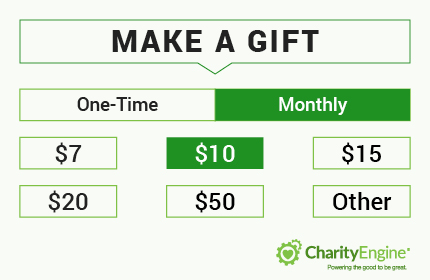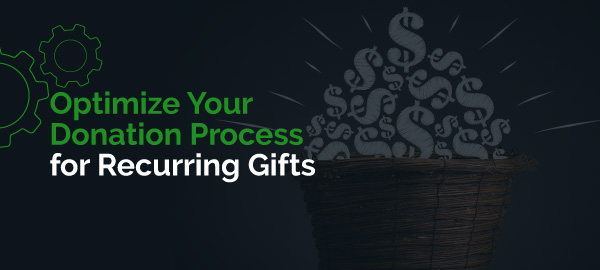Donations are the lifeblood of your nonprofit. Every donation, big or small, adds up to keep your nonprofit running. However, converting support into donations is often expensive, and sometimes the acquisition of one-time donations fail to cover the costs spent on marketing.
Of course, there’s no question that your nonprofit should continue reaching out to supporters for contributions. However, instead of asking for any kind of donation, you should emphasize the cultivation of recurring gifts. Recurring gifts are a reliable source of monthly revenue that adds up over time and helps your nonprofit form a core support base of regular donors.
Make sure that when supporters reach your donation page, making a recurring gift is as easy as possible. A well-optimized donation process builds on your marketing efforts, helping you earn more recurring gifts and gain long-term support. To help improve your recurring donors’ experience, this article will explore four donation process best practices:
- Add a checkbox or button to your donation page.
- Provide suggested giving amounts.
- Prompt donors to upgrade their gift to a recurring donation.
- Follow up to prevent donor lapse.
Keep in mind that earning and maintaining recurring gifts is a continuous process that requires regular upkeep. Think of donations not as a one time event but as a cycle. While the beginning of a supporters’ donor journey certainly deserves attention, also considering the other stages will help you retain donors, acquire more recurring gifts, and prevent donor lapse. Let’s get started.
Add a checkbox or button to your donation page.
Supporters who visit your donation page are at a key point in their engagement. They have found your cause through marketing materials, navigated through your website, and decided to make a gift. Make sure what they find on your donation page can persuade them to not just make a donation, but make a recurring one.
While many supporters will need to learn more about your nonprofit before deciding whether or not to become a recurring donor, others will make the decision the first time they visit your donation page. It’s a well-known fact that you have to ask in order to receive, and sometimes something as simple as adding a checkbox or button to opt-in to your recurring gift program can be enough to sway supporters.
When designing your donation page and recurring gift button or checkbox, make sure to consider:
- Your brand identity. Your recurring donation options should be branded to create a consistent experience for supporters. You can further emphasize your brand by adding details about what a recurring donation will accomplish. If you leverage suggested giving amounts (more on those soon), you might emphasize your mission by sharing the impact of a monthly gift over a one-time donation. For example, a nonprofit that provides school supplies might share that $25 per month pays for a class’s textbooks for a year, while a one-time gift can help buy a textbook for one or two students.
- Billing options. In order to accept recurring donations, you’ll need to have a payment processor that can handle recurring billing. Your recurring billing software is what allows your donors to set their recurring gift preferences and reliably transfer the gift to your nonprofit. Before creating a checkbox or opt-in method, make sure it’s connected to your recurring billing software.
- Page length. Donation forms should be kept short to prevent page abandonment where a donor exits the page before completing their gift. This means you’ll need to be thoughtful about how you format your donation form when adding extra elements such as your recurring gift buttons so that they don’t push the page to be too long.
Some nonprofits go the extra mile and provide supporters with multiple prompts to become recurring donors in case they missed the first chance. For some nonprofits, this may take the form of a pop-up that appears after a donor submits their gift, while others may prefer to offer the option in a follow-up thank you email confirming the initial donation.
Provide suggested giving amounts.
Many donors, especially first-time donors, are unsure about how much to give. By providing suggested giving amounts, you can help donors get a sense of what an appropriate donation amount is. In addition to streamlining the donation process, this can also increase your average donation size by setting an approximate donation floor.
Suggested giving amounts can also be used to persuade donors into joining your recurring giving program. Consider the following images:


Comparatively, the monthly giving option is much lower, though it adds up over time. To some donors, $7 a month might feel like less of an investment than a one-time $50 donation due to the initial cost difference. However, over the course of a year, the monthly donation will add up to be quite a bit more.
CharityEngine’s guide to monthly giving also explains how to make appropriate increase suggestions among your current donors. For example, if a donor gives $100 annually, it would be quite a jump in fundraising to ask them to give $100 monthly. Additionally, the donor may not have the spending capacity to make such an adjustment, even if they wanted to.
Instead, consider the amount the donor is already giving and suggest incremental increases. In the case of the $100 annual donor, you might instead ask them to consider giving $10 monthly, which isn’t a significantly increased financial burden, but also earns your nonprofit an extra $20 a year.
Prompt donors to upgrade their gift to a recurring donation.
Your donation form isn’t your only opportunity to encourage donors to join your recurring gift program. As mentioned, many donors need to establish a long-standing relationship with your nonprofit before they’ll be comfortable becoming a recurring donor.
For these supporters, you’ll need to identify who is a potential recurring donor and make your ask at an appropriate moment in their donor journey. Before asking someone to become a recurring donor, consider:
- How you can make the upgrade process as convenient as possible. Upgrading one-time donations to recurring gifts should be an easy process for your supporter. Consider giving donors control over their monthly giving amounts. Doing so allows them to update their financial information and upgrade their donations without needing to get in touch with a member of your staff.
- When you ask. There are a few times where asking donors to upgrade to a recurring gift will be more appropriate than others. For example, it makes sense to prompt a donor to consider giving a recurring gift the first time they give. However, if they continue to browse your website, you might want to delay asking for a recurring gift a second time through a pop-up in such quick succession.
- If it makes sense to ask this specific donor. There may be times where it’s inappropriate to ask for a recurring donation, specifically when it comes to your major donors. Instead, use wealth screening tools and look into giving trends to identify supporters who give in larger amounts repeatedly but irregularly. These supporters could be better candidates for your monthly giving program.
Additionally, avoid sending out automated mass emails asking all of your donors to upgrade to recurring gifts. Instead, segment your donors so these messages reach supporters who are the most likely to consider joining your recurring giving program, and avoid sending them to supporters who already give recurring donations.
Follow up to prevent donor lapse.
Recurring donations are ultimately more cost-effective than one-time gifts. Nearly every report on donor retention shows that it’s far cheaper to invest in the donors you currently have than to replace them with new ones.
In order to keep your recurring giving program going strong, you’ll need to continue cultivating donor relationships after they sign-up for your recurring giving program. Neglecting donor relationships can churn donors, losing previously reliable revenue and stifling your nonprofit’s potential growth.
Donor lapse can happen for all sorts of reasons, and Dataro’s guide to donor retention outlines a few ways you can prevent donors from lapsing:
- Identify at-risk donors. Before you can prevent donor lapse, you need to know which of your donors are at-risk. There are a few signs to look for, such as donors who have not opened any recent messages from your nonprofit and those who cancelled a scheduled payment. You can also survey your donors to get a general sense of how they feel about your nonprofit, which might also point to potential areas of improvement.
- Personalize messages. You should personalize your messages to each donor, especially those at risk-of leaving your recurring gift program. Consider making a segment of at-risk donors and send them messages that express gratitude and demonstrate their impact. In this personalized email stream, avoid asking at-risk donors to make additional gifts or increase their donation amount.
- Follow up on failed payments. Sometimes donors lapse not because they aren’t interested in donating, but because they experience a failed credit card payment. In these cases, follow up with your donor to resolve the issue so a change in credit cards doesn’t remove them from your recurring gift program. Some nonprofits even take the extra initiative to reach out to donors with cards that are about to expire to catch the problem early.
Your CRM or donation management software should help you track these data points. The right CRM should have reporting tools that allow you to identify trends in both individual supporters’ donation history and in overall donation trends. Plus, a CRM with communication tools can also allow you to segment your recurring donors and follow up with them as needed to help them continue their donor journey.
Recurring gifts are donations you can count on. To make the most of your recurring gift program, ensure that signing up is as easy as possible for donors and give them multiple opportunities to do so. Then, focus on cultivating relationships, both for those who are considering joining your recurring giving program and those who might be considering leaving it.
Author: Leigh Kessler is VP of Marketing and Communications at donor management software platform CharityEngine and a frequent speaker on branding, fundraising, data and technology. He is a former nationally touring headline comedian and has appeared on numerous TV shows including VH1’s “Best Week Ever”, CNN’s “Showbiz Tonight”, Discovery Channel & Sirius Radio. He has overseen and informed research and branding strategies for some of the most well known brands in America.
